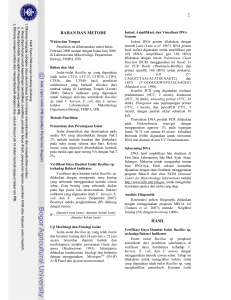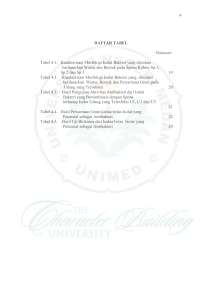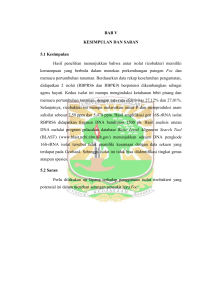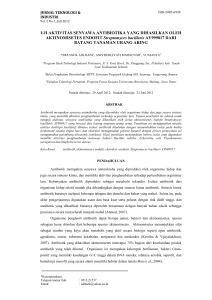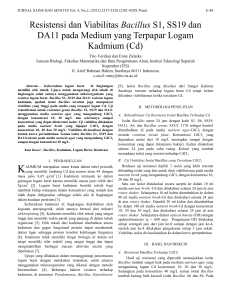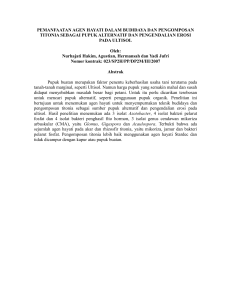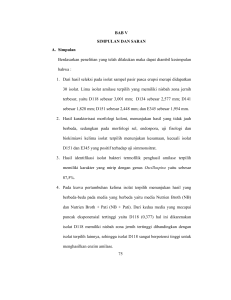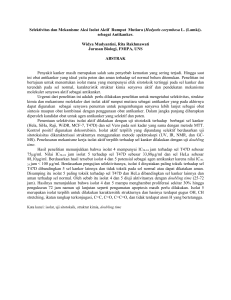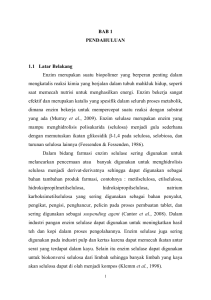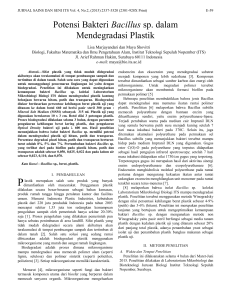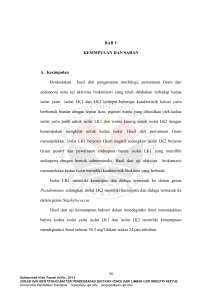kata pengantar
advertisement
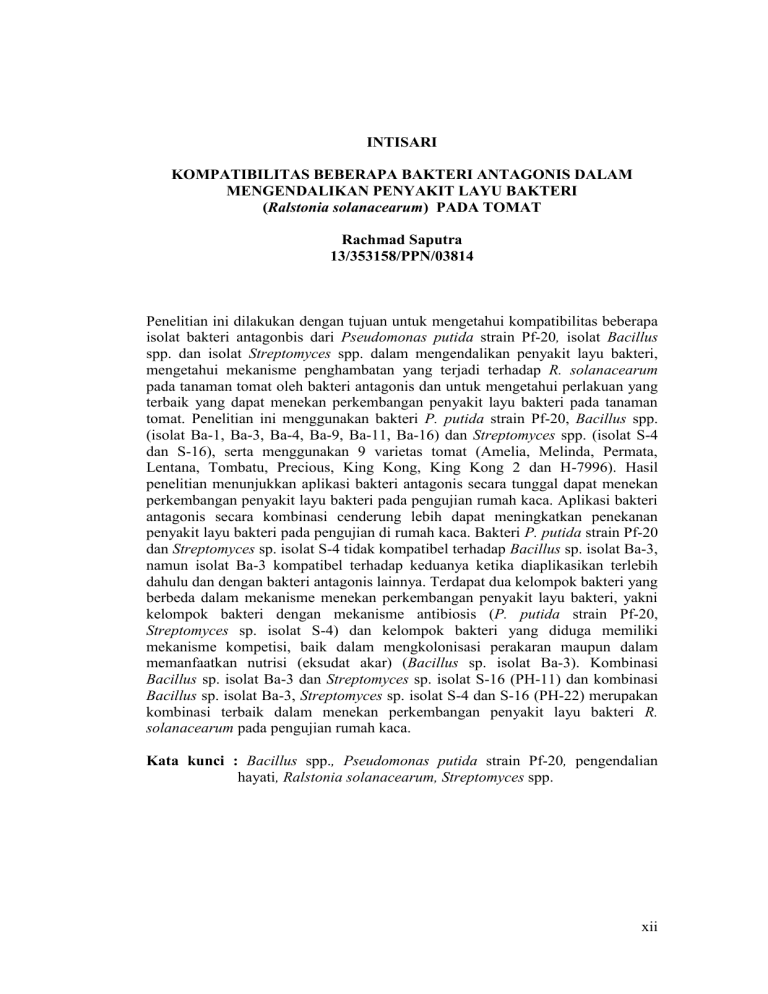
INTISARI KOMPATIBILITAS BEBERAPA BAKTERI ANTAGONIS DALAM MENGENDALIKAN PENYAKIT LAYU BAKTERI (Ralstonia solanacearum) PADA TOMAT Rachmad Saputra 13/353158/PPN/03814 Penelitian ini dilakukan dengan tujuan untuk mengetahui kompatibilitas beberapa isolat bakteri antagonbis dari Pseudomonas putida strain Pf-20, isolat Bacillus spp. dan isolat Streptomyces spp. dalam mengendalikan penyakit layu bakteri, mengetahui mekanisme penghambatan yang terjadi terhadap R. solanacearum pada tanaman tomat oleh bakteri antagonis dan untuk mengetahui perlakuan yang terbaik yang dapat menekan perkembangan penyakit layu bakteri pada tanaman tomat. Penelitian ini menggunakan bakteri P. putida strain Pf-20, Bacillus spp. (isolat Ba-1, Ba-3, Ba-4, Ba-9, Ba-11, Ba-16) dan Streptomyces spp. (isolat S-4 dan S-16), serta menggunakan 9 varietas tomat (Amelia, Melinda, Permata, Lentana, Tombatu, Precious, King Kong, King Kong 2 dan H-7996). Hasil penelitian menunjukkan aplikasi bakteri antagonis secara tunggal dapat menekan perkembangan penyakit layu bakteri pada pengujian rumah kaca. Aplikasi bakteri antagonis secara kombinasi cenderung lebih dapat meningkatkan penekanan penyakit layu bakteri pada pengujian di rumah kaca. Bakteri P. putida strain Pf-20 dan Streptomyces sp. isolat S-4 tidak kompatibel terhadap Bacillus sp. isolat Ba-3, namun isolat Ba-3 kompatibel terhadap keduanya ketika diaplikasikan terlebih dahulu dan dengan bakteri antagonis lainnya. Terdapat dua kelompok bakteri yang berbeda dalam mekanisme menekan perkembangan penyakit layu bakteri, yakni kelompok bakteri dengan mekanisme antibiosis (P. putida strain Pf-20, Streptomyces sp. isolat S-4) dan kelompok bakteri yang diduga memiliki mekanisme kompetisi, baik dalam mengkolonisasi perakaran maupun dalam memanfaatkan nutrisi (eksudat akar) (Bacillus sp. isolat Ba-3). Kombinasi Bacillus sp. isolat Ba-3 dan Streptomyces sp. isolat S-16 (PH-11) dan kombinasi Bacillus sp. isolat Ba-3, Streptomyces sp. isolat S-4 dan S-16 (PH-22) merupakan kombinasi terbaik dalam menekan perkembangan penyakit layu bakteri R. solanacearum pada pengujian rumah kaca. Kata kunci : Bacillus spp., Pseudomonas putida strain Pf-20, pengendalian hayati, Ralstonia solanacearum, Streptomyces spp. xii ABSTRACT COMPATIBILITY OF SOME ANTAGONISTIC BACTERIA IN CONTROLLING BACTERIAL WILT DISEASE (Ralstonia solanacearum) IN TOMATO Rachmad Saputra 13/353158/PPN/03814 This study was conducted to determine the compatibility of some antagonistic bacterial isolates of Pseudomonas putida strain Pf-20, isolates of Bacillus spp. and isolates of Streptomyces spp. in controlling bacterial wilt disease, knowing the mechanism of inhibition that occurs against R. solanacearum on tomato plants by antagonistic bacteria and to determine the best treatment that can suppress the development of bacterial wilt disease in tomato plants. This study uses the bacterium P. putida strain Pf-20, Bacillus spp. (isolates Ba-1, Ba-3, Ba-4, Ba-9, Ba-11, Ba-16) and Streptomyces spp. (isolates S-4 and S-16), and also using 9 varieties of tomato (Amelia, Melinda, Permata, Lentana, Tombatu, Precious, King Kong, King Kong 2 and H-7996). The results showed antagonistic bacteria in a single application can suppress the development of bacterial wilt disease in greenhouse tests. Applications antagonistic bacteria in combination tends to increased the suppression of bacterial wilt in greenhouse testing. P. putida strain Pf-20 and Streptomyces sp. isolate S-4 is not compatible to the Bacillus sp. Ba-3 isolate, but Ba-3 isolate compatible to both when applied in advance and with other antagonistic bacteria. There are two distinct groups of bacteria in the mechanism of suppressing the development of bacterial wilt disease, which is a group of bacteria with antibiosis mechanism (P. putida strain Pf-20 and Streptomyces sp. isolate S-4) and a group of bacteria that is believed to have a mechanism of competition, both in the colonized roots as well as in the use of nutrients (root exudates) (Bacillus sp. isolate Ba-3). Combination of Bacillus sp. isolate Ba-3 and Streptomyces sp. isolate S-16 (PH-11) and combination of Bacillus sp. isolate Ba-3, Streptomyces sp. isolates S-4 and S-16 (PH-22) is a combination that has a better potential in suppressing the development of bacterial wilt disease R. solanacearum in greenhouse testing. Keyword : Bacillus spp., biological control, Pseudomonas putida strain Pf-20, Ralstonia solanacearum, Streptomyces spp. xiii
